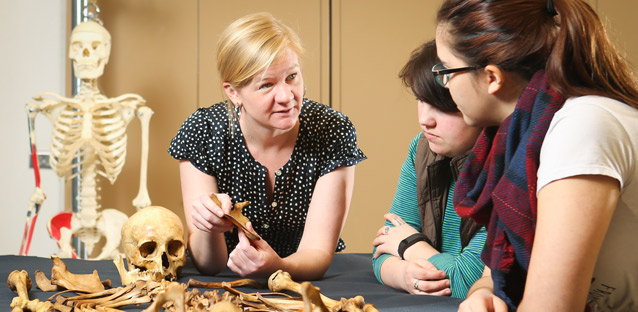Skeleton Crews
UNC anthropologist Britney Kyle and her students reconstruct the past by examining bones of ancient civilizations
Dead people may not tell tales, but their bones do. Britney Kyle, Ph.D., is working with her students to learn more about how humans evolved, lived, suffered or succeeded nearly 3,000 years ago, and she’s calling on bones to tell the stories of long-ago populations.
“We study human skeletons from an archaeological context and look at the impacts of colonization in the Mediterranean,” Kyle explains.
A biological anthropologist and assistant professor of Anthropology at UNC, Kyle co-directs the Bioarchaeology of Mediterranean Colonies Project with Laurie Reitsema, an assistant professor at the University of Georgia. Their project includes research at seven colonies and two mother-cities on the Mediterranean and Black seas. It was recently named a National Science Foundation funded Research Experience for Undergraduates (REU) site.
With NSF funding, Kyle spends eight weeks each summer with about 10 undergraduates from across the country. In Italy, students examine bones from 12,000 skeletons that are thousands of years old, learn research skills and begin to build the foundation for their own research projects.
What You Can Learn from Bones
Researchers use isotope analysis, a chemical process that looks at elements in excavated bones, and DNA testing to determine an individual’s:
- Nutrition (malnutrition)
- Health (disease)
- Geography (migration patterns)
Resulting data can help establish patterns and reveal ethnic inequality, evolution, human adaptation and the impact of social, cultural and environmental disruption.
“Your skeleton records a lot of your life events,” Kyle says, explaining how bones can tell anthropologists about a life lived long ago. “We can tell if a person was stressed (by malnutrition or disease, for example) by looking at levels of stress over time.”
Using this information, Kyle and her students can correlate what they’ve learned with historical documents and social histories. They can also determine migration patterns using isotope analysis to determine where someone grew up, versus where they died. They’ve begun using DNA tests as well.
The populations Kyle has studied lived nearly 3,000 years ago, including colonies in Sicily, Greece and an area called Apollonia in Albania. “In Albania, I found that at the colony (which was made up of local Illyrians, with a small amount of Greeks), the local population’s health definitely declined during colonization.”
That information helps Kyle explore the regional origins of ethnic inequality, evolution, human adaptation and the impact of social, cultural and environmental disruption on populations.
“In some ways people are surprised by how much you can learn from a skeleton,” Kyle says. “Our goal is to bring those skeletons to life.”
–Debbie Pitner Moors


